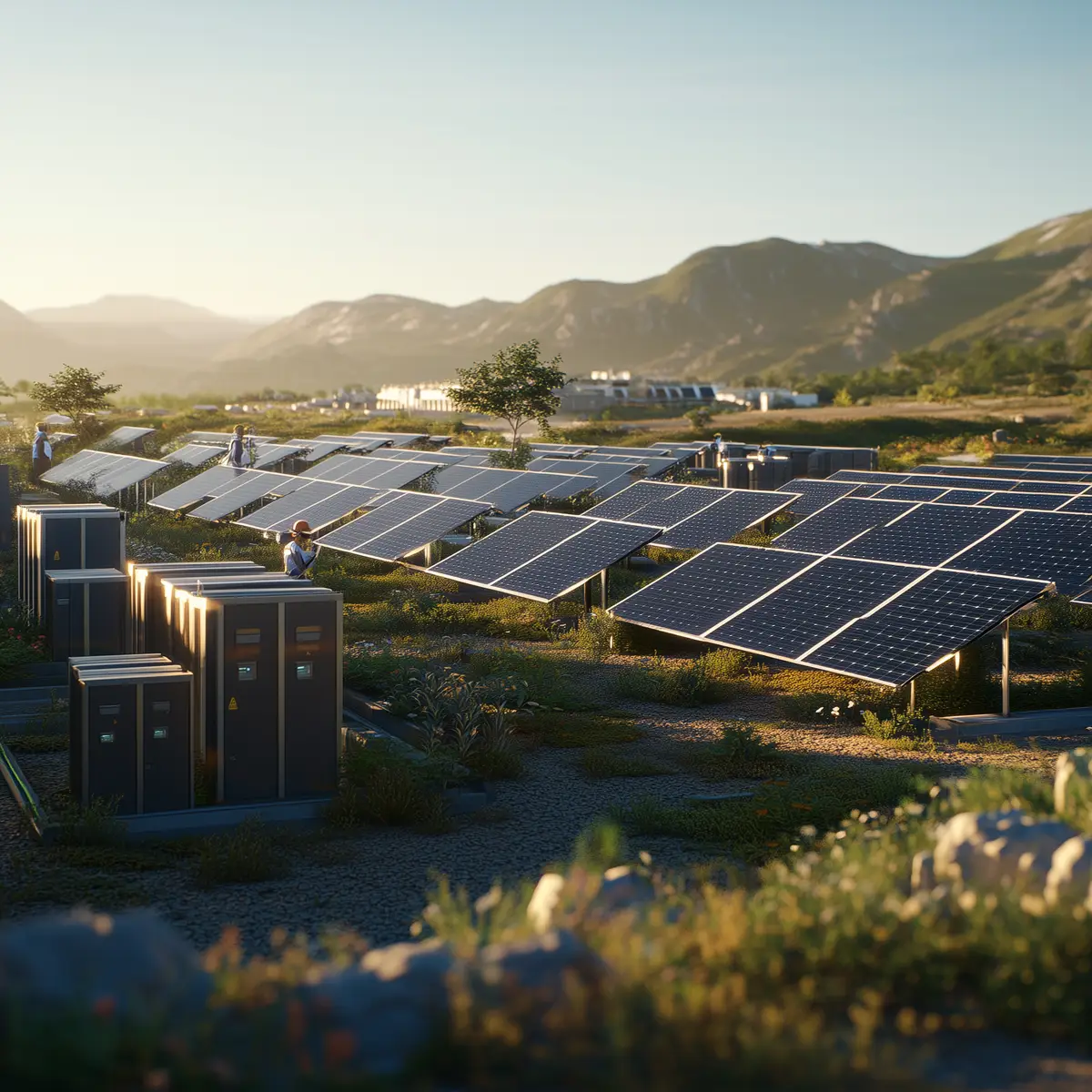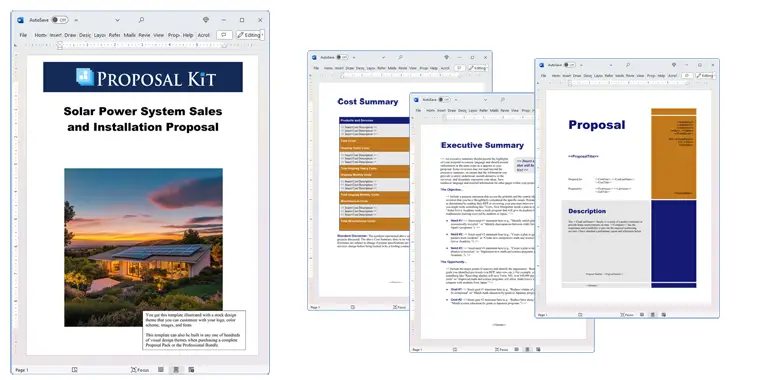How to write your Solar Power System Sales and Installation Proposal
We include this 22 page layout with every Proposal Pack. If you want this template to have a different visual design theme than the one illustrated here, purchase any Proposal Pack design and create this template using the purchased design theme. This template is included in every Proposal Pack. If you get a Proposal Pack or the Professional, you can also make any variation of this template with different chapters to suit your needs.
We typically include more chapters in the templates than most people will need to give everyone more variety in the chapters they may need. You can trim down a long template by removing pages you do not need or combining multiple chapter topics into one page.
 DOWNLOADABLE, ONE-TIME COST, NO SUBSCRIPTION FEES
DOWNLOADABLE, ONE-TIME COST, NO SUBSCRIPTION FEESYou can also create countless variations of this document to suit your needs using the included library of 2200+ chapters if ordering a Proposal Pack or Professional.
 What Our Clients Say
What Our Clients SayI bought the Proposal Pack last year in November and I will take this opportunity to thank you for your excellent customer service and the Proposal Pack did obtain the big contract I bought it for and many more. Now my client is so happy with my services that they want to put me on a retainer."
Mychele Rondeau
Related Article
Related Video
Related Templates
- Energy Efficiency Grant Project Proposal
- Sustainable Power for Eco Resort Proposal
- Solar Power System Grid and Storage Proposal
- Lighting Design and Installation Services Proposal
- Electrical System Upgrade Proposal
- Sustainable Energy Production Facility Proposal
- Smart Home Automation Project Proposal
- Energy Efficiency Proposal
- Environmental Program Proposal
- Commercial LED Lighting Product Sales Proposal
What's the best way to write your solar power system sales and installation proposal?
When it comes to creating a proposal for selling and installing solar power systems, Proposal Kit offers a proven solution. This software and template library simplifies the complex process of proposal writing, making it accessible even to those with little experience. By providing a comprehensive line item quoting database, Proposal Kit allows users to easily create detailed cost summaries, quotes, estimates, and budgets.
Do you need to write a solar power system proposal for your business or project? If so, the Proposal Kit is designed for you.
What Types of Projects Are Solar Power System Sales and Installation Proposal Written For?
Solar power system proposals are used for a variety of projects. Here are some examples of the kinds of projects that such proposals are written for:
- Installation of solar panels for commercial office buildings
- Solar energy systems for educational institutions
- Residential solar power system installations
- Solar farms for utility companies
- Solar-powered solutions for manufacturing plants
- Rooftop solar installations for retail outlets
- Off-grid solar power systems for remote communities
- Solar energy projects for agricultural facilities
- Solar panel installations for government buildings
- Large-scale solar power systems for industrial complexes
- Solar energy solutions for data centers
- Carport solar panel installations
- Solar power systems for sports facilities
- Community solar garden projects
- Solar installations for healthcare facilities
- Solar solutions for transportation hubs
- Solar water heating systems for resorts
- Solar power systems for telecommunications facilities
- Microgrid solar power projects
- Solar installations for religious institutions
Chapters this template is built with
There is no one-size-fits-all premade template for solar power system proposals that covers every situation. This is why Proposal Kit helps you to customize templates to suit any project's unique demands. Here are examples of chapters from the content library that can be used in this type of proposal:
Cover Letter
The Cover Letter sets the stage for your proposal. It introduces your company and the purpose of the proposal, creating a professional first impression that captures the recipient's interest. For a solar power system proposal, the cover letter should succinctly outline the benefits of switching to solar energy, emphasizing cost savings and environmental impact while inviting the client to explore the detailed proposal.
Executive Summary
An Executive Summary provides a concise overview of the proposal's main points. It's crucial to highlight the benefits of your solar power system to decision-makers. In this section, briefly describe the scope of the project, expected energy savings, return on investment, and how the proposal aligns with the client's sustainability goals.
Location Analysis
Location Analysis examines the proposed site's suitability for solar power installations, including sunlight exposure, shading, and structural considerations. This chapter should include a detailed report on the site's solar potential, any challenges such as obstructive shading or structural limitations, and proposed solutions.
Project Background
In the Project Background, you provide context. Explain why the project is necessary and how it aligns with the client's goals and sustainability objectives. Discuss current energy consumption patterns, carbon footprint, and how the project supports the client's environmental or economic objectives.
Installation Details
Installation Details cover the technical topics, such as installation timelines, team qualifications, and safety measures to ensure a smooth execution. This section should provide a step-by-step timeline from initial site preparation to system activation, highlighting the team's certifications and expertise in solar installations.
Equipment
The Equipment section lists the solar panels, inverters, and other components you plan to use. Detailing their specifications assures the client of their quality and reliability. Include information on the efficiency, durability, and warranty of the equipment, as well as how these components were selected to meet the client's specific energy needs.
Permits and Licenses
This section outlines the necessary Permits and Licenses required for the project, demonstrating your compliance with local regulations. Describe your experience in navigating the permitting process and how you will handle all necessary documentation, ensuring that the project remains on schedule.
Eco-Friendly
The Eco-Friendly chapter emphasizes the environmental benefits and sustainability features of your solar power system, appealing to eco-conscious clients. Highlight the reduction of carbon emissions, conservation of natural resources, and any innovative eco-friendly technologies incorporated in the project.
Specifications
Specifications provide detailed technical information about the system design and performance, ensuring transparency and precision. This chapter should include schematics, system capacity, energy output expectations, and any technological innovations, such as smart grids or battery storage solutions.
System Requirements
Outline the System Requirements necessary for optimal operation, including infrastructure needs and any client-supplied components. Detail any electrical upgrades, storage requirements, or additional infrastructure needed and how these will be integrated into the client's existing systems.
Operating Costs
Operating Costs detail the expected ongoing expenses, such as maintenance and potential energy savings, helping clients understand the long-term financial benefits. Include a comparison of current versus projected energy costs, highlighting savings and any maintenance plans offered.
Cost/Benefit Analysis
A thorough Cost/Benefit Analysis demonstrates the project's financial feasibility, comparing initial costs against projected savings and revenue. Provide detailed financial models showing payback periods, long-term savings, and potential increases in property value due to the solar installation.
Price List
The Price List presents a breakdown of costs, including materials, labor, and additional services, offering clients a clear understanding of their investment. Ensure transparency by itemizing costs and explaining the value of each component, making it easier for the client to see where their money is going.
Recommendations
In the Recommendations section, suggest the best course of action for the client based on your expertise and the proposal's findings. Offer tailored advice on optimizing energy use, potential future expansions, or maintenance plans that could enhance system performance.
Experience
The Experience chapter showcases your previous work and expertise in solar power installations and building trust with potential clients. Share case studies of past projects, highlight client testimonials and discuss any awards or recognitions your company has received in the renewable energy sector.
Company History
Provide a snapshot of your Company's History to give clients assurance of your stability, growth, and long-term commitment to the industry. Detail your journey in the renewable energy field, emphasizing major milestones, key partnerships, and commitment to innovation and sustainability.
References
List References from past projects to offer clients reassurance through testimonials and endorsements from satisfied customers. Include contact information for previous clients willing to discuss their positive experiences and the impact of the solar installations on their operations.
Sustainability
Highlight your commitment to Sustainability and how your solar power systems contribute to a greener future for the client and the planet. Discuss your company's sustainability policies, how the proposal contributes to broader environmental goals and any certifications that underscore your commitment to green practices.
Standards Compliance
Standards Compliance ensures that your project adheres to industry and safety standards, safeguarding quality and reliability. Outline the standards your installations meet, any third-party certifications your products possess, and your commitment to high-quality workmanship and safety protocols.
Use cases for this template
Provider's Perspective: Securing a Lucrative Solar Farm Contract
The Challenge
Green Energy Solutions faced a challenge when they decided to pitch a solar farm project to a major utility company. Despite having a robust business plan and the technical expertise to back it up, the team found it difficult to articulate the project's financial benefits and the eco-friendly advantages in a persuasive manner. Their proposal needed to not only capture the attention of the utility company's board but also convincingly demonstrate why their solar solution was the optimal choice for long-term sustainability and cost-effectiveness.
The Solution
Recognizing the gravity of the task, Green Energy Solutions sought assistance from Proposal Kit. The comprehensive proposal writing software offered structured templates specifically designed for projects like theirs. These templates provided a clear framework that guided the team in organizing their thoughts and data efficiently. Proposal Kit's resources helped them weave together a coherent narrative that emphasized both the immediate and long-term benefits of the solar farm, making the information accessible and engaging for their audience.
The Implementation
Equipped with Proposal Kit's tools, Green Energy Solutions methodically created their proposal. They used the software's features to conduct a thorough Cost/Benefit Analysis, presenting a detailed financial case that showcased the economic advantages of their solar farm project. Furthermore, the line item quoting database allowed them to generate precise cost estimates, eliminating uncertainties and demonstrating their commitment to transparency. By highlighting the eco-friendly topics of the project through the Proposal Kit's templates, they communicated the environmental value to the utility company.
The Outcome
The proposal was met with enthusiasm by the utility company's decision-makers. Its clarity, professional presentation, and comprehensive analysis resonated with the board, who saw Green Energy Solutions as a trustworthy and capable partner. As a result, Green Energy Solutions won the bid, securing a long-term partnership with the utility company. This victory not only reinforced their position in the renewable energy sector but also opened new doors for future projects.
Employee's Perspective: Overcoming Deadline Pressures with Precision
The Challenge
Emily, an employee at Solar Innovations Corp, was entrusted with the responsibility of writing a proposal for a rooftop solar installation. The project had an approaching deadline, and Emily found herself overwhelmed by the complexity and volume of information she needed to compile. The pressure to deliver a comprehensive and persuasive proposal in such a short timeframe left her feeling stressed and uncertain about how to proceed.
The Solution
In her quest for a solution, Emily turned to Proposal Kit's extensive library and Wizard software. She discovered that the pre-designed templates could greatly streamline the proposal-writing process. Additionally, Emily used an AI writing tool to optimize content creation, drawing upon its capabilities to generate coherent and structured text for specific sections of the proposal.
The Implementation
The AI tool analyzed Solar Innovations Corp's website, extracting relevant information that Emily could use to enrich her proposal's content. With this AI-generated assistance, she customized the templates provided by Proposal Kit, ensuring that each section of the proposal was tailored to reflect the unique topics of the rooftop solar project. This combination of human insight and AI efficiency allowed her to meet the deadline with confidence and precision.
The Outcome
Emily's proposal was submitted on time, much to the relief of her team and the management. The client was impressed by the detailed financial analysis and the proposal's overall clarity, which clearly outlined the benefits of the solar installation. The project's approval not only secured a new contract for Solar Innovations Corp but also boosted Emily's confidence in handling high-pressure situations, establishing her reputation as a reliable and efficient member of the team.
Non-Profit Director's Perspective: Creating an Impactful RFP for Community Empowerment
The Challenge
At EcoFuture Initiative, Brian faced the challenging task of preparing a Request for Proposal (RFP) for solar panel installations in remote communities. His primary concern was how to articulate the unique challenges and benefits of the project to potential bidders. Brian aimed to attract companies that could not only execute the installations but also understand the broader social and environmental impact of bringing solar energy to underserved areas.
The Solution
Brian explored the resources offered by Proposal Kit and found that its customizable templates were perfectly suited for creating a comprehensive RFP. The software provided him with the tools to address specific project requirements while maintaining the flexibility to highlight the unique topics of the initiative. This approach allowed Brian to focus on the community benefits and sustainability goals, key topics that he wanted to emphasize in the RFP.
The Implementation
With Proposal Kit's extensive template library at his disposal, Brian tailored the RFP to meet the project's needs. He focused on creating sections that clearly defined the scope, objectives, and expected outcomes of the solar panel installations. By highlighting the potential community benefits and sustainability topics, Brian was able to create an RFP that resonated with organizations and was aligned with the EcoFuture Initiative's mission.
The Outcome
Brian's well-structured RFP successfully attracted multiple qualified bidders, each demonstrating a strong alignment with the project's goals. The clarity and detail of the RFP ensured that EcoFuture Initiative received competitive and feasible proposals, enabling them to select the best partner for the project. This achievement not only advanced the organization's mission but also underscored the importance of effective proposal writing in the non-profit sector.
Conclusions and Recommendations
Creating a solar power sales proposal can be a challenging task without the right tools. Proposal Kit simplifies this process, offering customizable templates and software that address every topic of the proposal. From cost summaries to eco-friendly benefits, Proposal Kit ensures your proposal is comprehensive and compelling. Whether you're a service provider, an employee on a tight deadline, or a non-profit director, Proposal Kit can help you achieve your goals with confidence.
Also Known As
This template may also be referred to in different ways or be used in more specialized situations, such as:
- Solar Energy Proposal
- Renewable Energy Plan
- Solar Installation Document
- Photovoltaic System Proposal
- Green Energy Project Proposal
- Solar Panel Installation Offer
- Sustainable Power Proposal
- Solar System Quotation
- Eco Power Proposal
- Solar Project Submission
Abstract
 A well-written solar proposal is important in the competitive solar industry, serving as a powerful tool for solar installers, solar companies, and solar professionals to connect with potential customers and convert prospects into successful solar sales. An effective solar sales proposal addresses customer needs, explains technical topics in simple language, and provides all the important details about the proposed solar system, including system specifications, energy production estimates, and a clear cost breakdown. By using advanced solar proposal software and customizable solar proposal templates, solar professionals can streamline the proposal creation process, eliminate manual data entry, and create accurate, professional proposals, whether working on commercial projects or residential installations.
A well-written solar proposal is important in the competitive solar industry, serving as a powerful tool for solar installers, solar companies, and solar professionals to connect with potential customers and convert prospects into successful solar sales. An effective solar sales proposal addresses customer needs, explains technical topics in simple language, and provides all the important details about the proposed solar system, including system specifications, energy production estimates, and a clear cost breakdown. By using advanced solar proposal software and customizable solar proposal templates, solar professionals can streamline the proposal creation process, eliminate manual data entry, and create accurate, professional proposals, whether working on commercial projects or residential installations.
A strong solar sales proposal should walk potential customers through the complete solar sales process, from project overview and solar design to technical details, financing options, and post-installation support. Key topics such as detailed installation process descriptions, system cost, energy usage analysis, production guarantees, and estimated savings build credibility and set realistic expectations. Addressing common pain points, like upfront costs, electricity costs, and the breakeven point, reassures prospects about the long-term value and potential savings of solar panel technology. Including financial incentives, tax credits, rebates, and net metering options demonstrates the many ways solar arrays and PV panels can make electricity more affordable on a yearly basis.
The proposal process should also highlight the benefits of renewable power, sustainability, and the positive impact of solar adoption on the environment. Incorporating customer testimonials, case studies, and references enhances trust and addresses more decision-makers involved in the agreement. For commercial customers and homeowners alike, providing a clear comparison of financing options, leases, and payment plans can make all the difference in closing deals and encouraging more deals. By integrating branding topics, contact details, all the important topics, and a personal touch, solar companies stand out from the competition and establish credibility in the market.
 Ultimately, solar proposal software and proposal templates enable solar professionals to save time, avoid errors from manual data entry, and create great solar proposals that answer questions, break down technical jargon, and allow customers to make informed decisions. As the solar market grows, the ability to create accurate, compelling, and affordable proposals that reflect the specific needs of each project can result in higher customer satisfaction, more opportunities, and greater success for solar installers and contractors working to promote renewable power solutions.
Ultimately, solar proposal software and proposal templates enable solar professionals to save time, avoid errors from manual data entry, and create great solar proposals that answer questions, break down technical jargon, and allow customers to make informed decisions. As the solar market grows, the ability to create accurate, compelling, and affordable proposals that reflect the specific needs of each project can result in higher customer satisfaction, more opportunities, and greater success for solar installers and contractors working to promote renewable power solutions.
A solar panel installation proposal serves as a cornerstone document for both many solar companies and stakeholders, ensuring that all parties involved - from commercial customers to many homeowners - fully understand the scope and value of a solar project. The creation of a successful solar proposal or effective solar proposal not only communicates the technical details and product specifications but also addresses customer concerns about space limitations, roof suitability, and the selection of the right solar panels or PV panels for their unique energy goals. By using Proposal Kit s extensive template library and design services, solar professionals can confidently create proposals that integrate key topics such as financing partners, application process steps, and system testing protocols, making sure every topic of the job is clear from the initial research phase to the lifetime performance guarantees.
In a market, creating professional documents with a great proposal is crucial for standing out as a leading solar installer. Proposal Kit enables direct integration of detailed energy production estimates and monthly kwh data, helping customers visualize their savings and the possibility of saving money in the long run. Proposals built with Proposal Kit can be shared on a mobile device, ensuring that decision-makers, stakeholders, and financial partners have immediate access to key takeaways wherever they are. The software s automated features allow companies to avoid common risks associated with manual calculations, while tips within the templates encourage effective communication and customer feedback.
 For larger system sizes or complex commercial projects, an effective solar panel installation proposal must determine the best approach to maximize the use of available space and optimize energy output. By including information from manufacturers and integrating data on product testing and warranties, solar companies can stand behind the reliability and durability of their offerings. Mentioning financing options - supported by financial partners - gives interested customers multiple ways to manage upfront costs, making solar more accessible and reducing perceived financial risk.
For larger system sizes or complex commercial projects, an effective solar panel installation proposal must determine the best approach to maximize the use of available space and optimize energy output. By including information from manufacturers and integrating data on product testing and warranties, solar companies can stand behind the reliability and durability of their offerings. Mentioning financing options - supported by financial partners - gives interested customers multiple ways to manage upfront costs, making solar more accessible and reducing perceived financial risk.
Ultimately, a great solar proposal encourages customer confidence by breaking down complex concepts into understandable points, discussing the integration with existing electrical infrastructure, and providing clear information about the agreement and terms. This attention to detail and customer-centered approach makes it easier to begin the journey toward renewable energy, save money on electricity bills, and achieve long-term sustainability goals. By adopting a structured proposal creation process and using Proposal Kit s resources, solar professionals can not only produce compelling proposals but also establish themselves as trusted advisors, helping clients navigate the application process, compare product options, and make informed decisions that are beneficial for both their finances and the environment.
An additional dimension of a strong solar panel installation proposal lies in its ability to clearly address customer questions and ensure that the customer understands every topic of the proposed system. In today s solar industry, it is important for solar companies to mention not only the technical specifics of PV panels but also to talk openly about how a proposed system will be tailored to meet individual energy usage patterns and space requirements. By doing so, proposals bridge the gap between technical details and practical outcomes, guiding customers through the transition to renewable energy.
 Ultimately, a solar proposal that incorporates these practices fosters transparency and trust, making it easier for potential clients to envision the tangible benefits of solar power. When stakeholders feel their unique needs and goals are being heard and addressed, they are far more likely to move forward with confidence. This approach not only improves communication but also helps customers fully understand the long-term value - both financial and environmental - of investing in PV panels and solar technology. Proposals that successfully address customer concerns, clearly mention all relevant features, and talk through the advantages and requirements ultimately lead to more satisfied clients and greater adoption of solar solutions in the marketplace.
Ultimately, a solar proposal that incorporates these practices fosters transparency and trust, making it easier for potential clients to envision the tangible benefits of solar power. When stakeholders feel their unique needs and goals are being heard and addressed, they are far more likely to move forward with confidence. This approach not only improves communication but also helps customers fully understand the long-term value - both financial and environmental - of investing in PV panels and solar technology. Proposals that successfully address customer concerns, clearly mention all relevant features, and talk through the advantages and requirements ultimately lead to more satisfied clients and greater adoption of solar solutions in the marketplace.
Frequently Asked Questions
How can I ensure that my solar power system proposal is comprehensive and covers all necessary details?
To ensure your solar power sales proposal is comprehensive, focus on including key components like the project background, installation details, and cost analyses. Use Proposal Kit's customizable templates to address these areas thoroughly, which not only provides clarity to your potential client but also demonstrates professionalism. The templates guide you in incorporating everything from technical specifications to sustainability benefits, ensuring that no crucial detail is overlooked. By covering all necessary topics, you increase the likelihood of your proposal being well-received by decision-makers.
What are the most important sections to include in a solar power system proposal?
In a solar power sales proposal, the most important sections typically include an Executive Summary, Location Analysis, Equipment specifications, and Cost/Benefit Analysis. These sections are important because they provide a clear overview of the project's objectives, the feasibility of the installation site, the quality and performance of the equipment being used, and a financial perspective that outlines the potential return on investment. Proposal Kit offers templates that help you structure these sections, ensuring that your proposal addresses the key concerns of prospective clients.
How do I calculate and present the financial benefits in my proposal effectively?
To calculate and present the financial benefits in your solar power sales proposal, use Proposal Kit's line item quoting database for precise cost estimation. This tool helps in creating detailed cost summaries, quotes, and budget analyses that clearly demonstrate the financial benefits of choosing your solar solution. Highlight long-term savings, potential tax incentives, and ROI to make your proposal more appealing. By providing a clear and detailed financial analysis, you can reassure clients of the value and viability of your solar power project.
How can I highlight the sustainability topics in my solar power proposal?
Highlighting sustainability in your solar power sales proposal is crucial to appeal to environmentally conscious clients. Use Proposal Kit's templates to include sections specifically focusing on eco-friendly benefits, such as reductions in carbon footprint and reliance on renewable energy sources. Discuss how your project aligns with broader environmental goals and contributes to sustainable development. By emphasizing the positive environmental impact, you not only cater to clients' values but also strengthen the overall appeal of your proposal.
How do I customize my proposal for different types of solar power projects?
Customizing your solar power sales proposal for various project types is important for addressing specific client needs. Proposal Kit's extensive library of templates allows you to adapt your proposal for diverse situations, such as commercial installations, residential setups, or community solar gardens. Each template can be tailored to emphasize relevant project details, such as unique site conditions or specific client requirements. By customizing your proposal, you demonstrate the flexibility and adaptability of your services, which can significantly enhance your chances of winning the bid.
20% Off Discount
![]() Add To Cart This Word Template
Add To Cart This Word Template
 Add To Cart Proposal Pack for Any Business
Add To Cart Proposal Pack for Any Business
 Add To Cart Proposal Kit Professional
Add To Cart Proposal Kit Professional
 4.7 stars, based on 849 reviews
4.7 stars, based on 849 reviewsProposal Kit chapters used in this template
Cover Letter, Title Page, Table of Contents, Executive Summary, Project Background, Equipment, Location Analysis, Installation Details, Permits and Licenses, Eco-Friendly, Sustainability, Specifications, System Requirements, Standards Compliance, Operating Costs, Cost/Benefit Analysis, Price List, Recommendations, Company History, Experience, References, Back Page
Line Item Automated Chapters
If you purchase a Proposal Pack or the Professional Bundle, these proposal pages are generated using an automated line-item database in the included Wizard software.
Operating Costs, Cost Benefit Analysis
You use this proposal for
- General business proposal
- Non-technical proposal
- Project pitch proposal
- Construction, contracting, building proposal
- Real estate, property proposal
- Nature, environmental proposal
- Energy proposal
How to create this template with Proposal Pack Wizard
You can create this document using any of the logo-designed Proposal Packs. Pick any Proposal Pack with a logo design theme you like best; they will all work equally well. The Proposal Pack for Any Business is the pack with no extra added logos or colors - designed to be used plain or for you to customize with your logos and graphics.
The Proposal Pack design theme you purchase will determine the visual look of this template. The screenshot above only shows the plain generic design theme.
We include a library of chapters to be assembled based on your needs. All proposals are different and have different needs and goals. We designed Proposal Pack so you can customize the documents to suit your needs.
You will best create this document using the Proposal Pack Wizard - Expert Edition software to select this template and build it in the Proposal Pack logo design theme of your choice along with any desired customizations (such as adding additional chapters, removing unneeded chapters, changing the order of chapters, and importing your company logo). This template outlines a proposal for the described situation. Each user is responsible for typing in the actual content of the provided pages with their information to complete the proposal. Suggestions in the abstract may include features in higher-end packages and are facilitated by the selection of chapter templates to support the narrative of each proposal, which help guide the user in filling in the details.
The Wizard software's AI Writer will write the content of the pages of the template based on details provided for your company, client, project, financial details and other writing instructions. This will provide a personalized version of the template completely written and ready to edit.
Once finished, the AI Writer's Word-to-PowerPoint converter can transform your proposal, business plan, or other business documents into a PowerPoint slideshow. Save time and effort by letting the AI analyze every chapter to condense its content into talking points, visually matching the document, and providing a consistent package of presentation material with the click of a button.
You create this template using the Wizard software with an entire Proposal Pack library and software. We include the Expert Edition of the software in the Proposal Kit Professional. Microsoft Word for Windows is required to use the customizing software. You can also edit Word document templates in other office software such as Word for Mac. We will assist Mac users in assembling complex templates for their first project if they do not have the required platform to run the Wizard software.
How to Build Templates Featured on Proposal Kit Website
Many people find the Proposal Kit website after searching for a specific proposal. Once you've purchased and installed the software, how do you build that template you found in the first place? This video shows you how to build any proposal you see on the Proposal Kit website.
 Ian Lauder has been helping businesses write their proposals and contracts for two decades. Ian is the owner and founder of Proposal Kit, one of the original sources of business proposal and contract software products started in 1997.
Ian Lauder has been helping businesses write their proposals and contracts for two decades. Ian is the owner and founder of Proposal Kit, one of the original sources of business proposal and contract software products started in 1997.By Ian Lauder
 Published by Proposal Kit, Inc.
Published by Proposal Kit, Inc.


 Cart
Cart
 Get 20% off ordering today:
Get 20% off ordering today: 


 Facebook
Facebook YouTube
YouTube Bluesky
Bluesky Search Site
Search Site